More typos found:
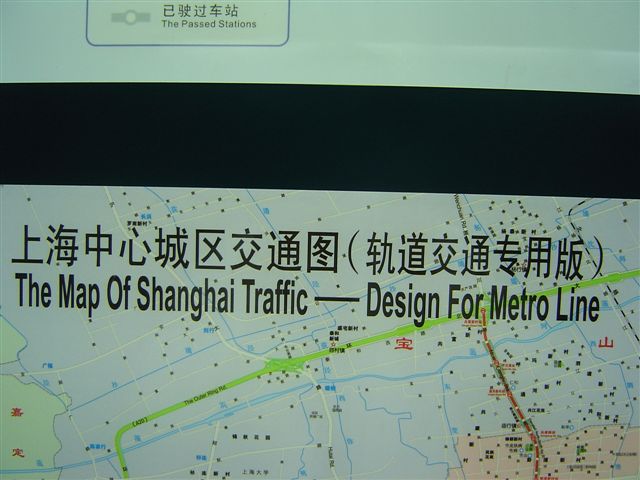
Picture taken by Jian Shuo Wang at Xujiahui Metro Station, Shanghai
“The Map of Shanghai Traffic – Design for Metro Line”
Did they really think that the map is about the traffic instead of the roads and areas? Design should be Designed. Metro Line should be Metro or Shanghai Metro. Actually, I don’t think they should put Designed for Metro Line in so big font.
Rail Transit Line 1 Full Diagram
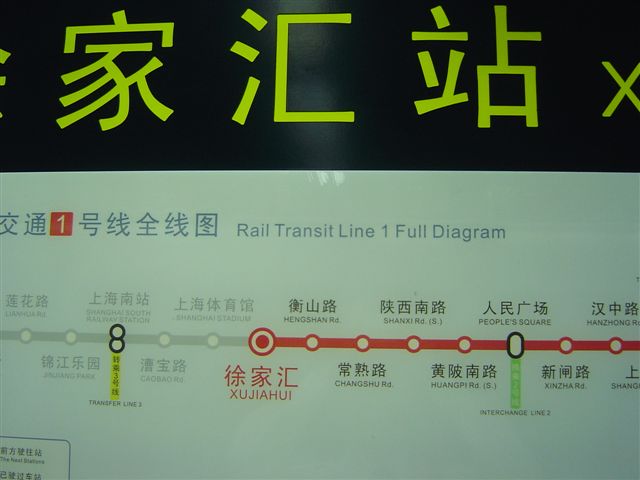
Picture taken by Jian Shuo Wang at Xujiahui Metro Station, Shanghai
This title is insteading.
Shanghai Rail Transit Line No 1
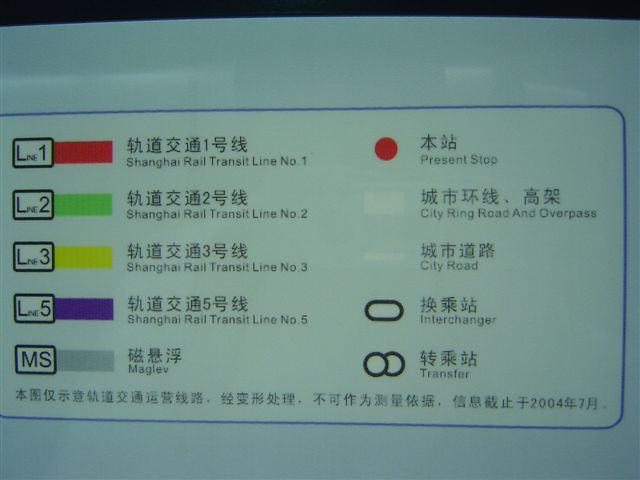
Picture taken by Jian Shuo Wang at Xujiahui Metro Station, Shanghai
I would prefer to call it Metro Line #1 instead of “Rail Transit Line No 1”. Is there a problem here? I am not sure.
Transfer Line 3
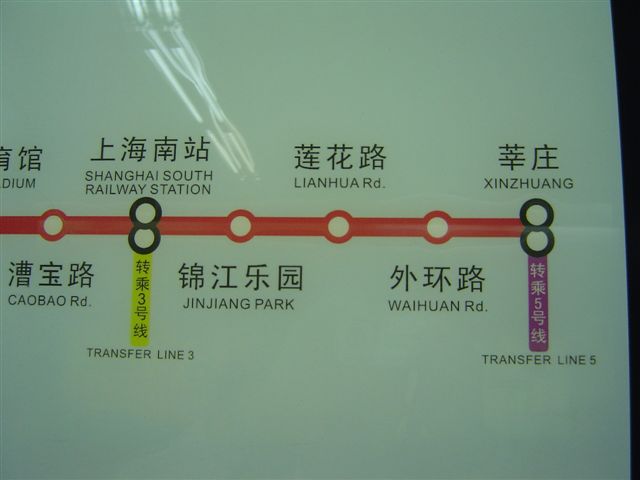
Picture taken by Jian Shuo Wang at Xujiahui Metro Station, Shanghai
The transit station was marked as “Transfer Line 3” and “Transfer Line 5”.
Chinese also has Problems
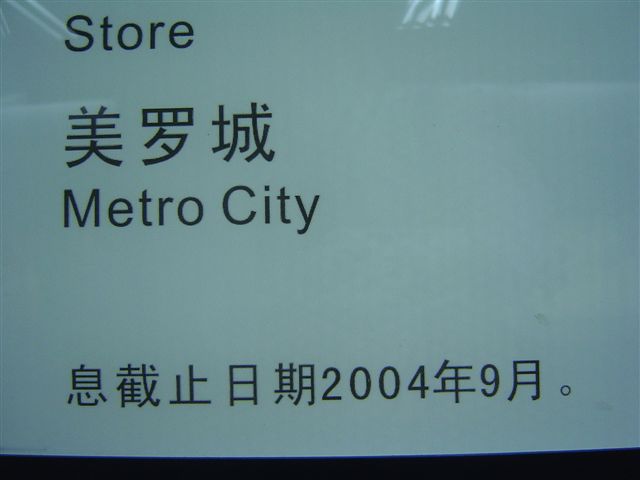
Picture taken by Jian Shuo Wang at Xujiahui Metro Station, Shanghai
There is error not only in English. Here is an exmaple of Chinese mistakes. They ignored Xin 信 in the sentence of Xinxi (Information or 信息).
More and More People Got Involved

Photo submitted by Ou Yuxian
Mr. Ou sent me email to report another suggestion to Shanghai Metro. At every station, there are many boards like this. Mr. Ou said in the mail:
… Here I am attaching a photo they took in a metro stattion. On one board, it says “Danger! Jumping into the tunnel is forbidden”. According to the experience I have, it would be a more proper way to say “Danger! No jumping into the tunnel.”
Thanks Mr. Ou. I have put the picture onto the ShanghaiWiki.MetroTypos page and will hand over the printed version of the page to Metro Corp.
Actually, this version has been much better than the previous one. I remember the older version was:
跳下站台进入隧道。危险!
There was no English in the old version. The translation will be
Jump Off the Platform and Enter the Tunnel. Danger !
That sign was really confusing.
Follow Ups
As Miss Wu, the nice lady from Metro Xujiahui said, she had reported the problem to the management and they will order to correct it. However, I do worry about the quality of the next version without a good sense of English.
According to the authority’s master plan for Shanghai’s rail transit system, there will be “R” lines, “M” lines and “L” lines. R lines are long distance, large capacity transit, connecting new towns to the city center (R for regional, i guess). M lines are city-wide, shorter distance, smaller capacity but higher frequency (M for metro, my guess). L lines are feeder lines connecting living quarters to the trunk R and M lines. L for Light transit.
Now we have real confusion. The above code is not used in actual practice, because they somehow feel ordinary citizens won’t be able to make out the difference between R, M and L. So every line is assigned a number for simplicity sake. For example, R1a in the master plan (as the symbol suggests, extension of Regional Line #1, which is the current Metro Line #1. ) got the name Metro Line #5. But the word “Metro” would be inappropriate for a light transit line. “Rail Transit” would solve the problem, as Metro and Light transit are subsets of Rail Transit. Correspondingly, they changed 地铁 to 轨道交通, as 地铁 and 轻轨 are subsets of 轨道交通. Maybe that’s the rationale behind.
But I totally agree with you this change only adds to confusion. The problem with coding the lines is that there has never been a definitive standard. Even the Chinese names lack consistency, as Line #3 is still called Pearl Line and mistakenly referred to as light transit. The only way to solve the problem is to urge the authority to develop a FINAL naming system once and for all.
jianshuo, is it possible to put up links to shanghaiwiki and bustop projects on your home page? don’t want to dig into your extensive archives for these links :D
The subway system in Boston, USA has an interesting way to communicate to passengers. Instead of calling them lines 1, 2, 3, 4 or North, South, East, West, they name the lins the Red Line, Green Line, Blue Line, and Silver Line, etc. Then they color coded everything accordingly. All maps, station and directional signs, gates, station benches, tickets, the trains’s exterior and interior color markings, the seat leather, and even the conductor’s uniforms are red for the Red Line, green for the Green Line, and so on. It is a very effective and user-friendly system. Travellers have a clear idea of which line they are on and don’t have to remember much. Foreigners don’t have to read much either. The stations’ entrance colors are brightly visible from a distance and above the crowds. Transfer between lines becomes effortless, almost.
I am very displeased with your tirade of the harmless misuse of English on signs in Shanghai’s public transportation system. I can go on and on about how your reaction was exaggerated and how your criticism was unfounded, but I hope what follows will suffice to demonstrate to you the irony of your complaint.
I randonly chose an earlier entry of yours and took a quick look at the first two paragraphs. All comments are in parentheses.
“Winners never quite (quit) and quitters never win”. This is what I learnt from the (omit the) two years of blogging. I started doing something with quite interesting ideas (awkward), but it stopped by (for) some reason. Many people have brilliant ideas but not many can stick to (with) it (them).
I started the My City, My Bus Stop project in the first week of this year (awkward), but the system failed because of migration to the new server. It involves many works (much work) to rebuild the whole thing and it did take some time to rebuild it. My friend Isaac has asked about the status of the project and so does (have) some contributors. Although it took about half (a) year to fix it, I finally fixed the problem and now everything works. I bet we can start from this new start (bad style) – the My City, My Bus Stop Project didn’t die (hasn’t died) yet.
mc_dean, thanks for your correction of the typos and grammer mistakes of the sample entry. I have updated those paragraphs according to your suggestion. Please don’t take it as a tirade. I admit that I was angry that the advertising company cost the Metro so much money and only gave out signs in such poor quality. They hang the boards at the most siginificant places in one of the busiest Metro Station. I have reported the problems to news media and to Metro Corp. and they have took actions to correct them. The ShanghaiWiki.MetroTypos wiki site is the place we can collaborate to give a better translation – I know mine is far from perfect, or even from the correct translation. After we get some feedback, I will print what we get and give it to Metro. I talked with them before and they appreciate the help of the community. Regarding the errors on this site itself, I admit that there are many – at least more than those found in Metro.
This is how I explained in this article:
http://home.wangjianshuo.com/archives/20040616_volunteers_wanted.htm
I have proof read most of my articles myself (if time allows). I read the published entry(so HTML code is not displayed), mark mistakes and go back to MovableType to correct them. But English is not my native language and there are still many grammar and spelling errors in every article. I am aware of it. :$ (type this into your MSN Messenger and you can see what emotion it prepresents)
It is always easy to critise than to build. I critising the typos in the Metro in order to build something correct. You corrected my typos in order to see improvement. In a text area like comment box and my editing box, to void typo is not easy though.
Fraud on Subway.
A few weeks ago, my wife and I bought a ticket from the counter for People’s Sq to South Rail Station. We paid three RMB each, the correct price. However, we found out exiting the S Rail Station that the lady only gave us 2 RMB tickets. Fortunately, the guard let us out.
My questions: Is this trickery common? It would seem so, due to my impression that the guard at S. Station has seen many instances of this, and let us leave quickly. Is anything being done about this fraud?
WJS,
I hope you understand that I don’t have any problem with your slightly imperfect writing. It almost always puts the point across effectively and, besides, the slight imperfections only give it an authentic Chinese feel, as some of your readers have commented earlier. But I hope you see my point here. The purpose of the signs in English are to communicate to English speaking commuters, and to this end the typos and grammatical mistakes are harmless. It wouldn’t make sense to spend extra $ just so that these signs would be grammatically and idiomatically perfect. As you might have noticed from the response to your request for corrections on your blog entries, native English speakers-those who actually obtain information from these signs in English are more tolerant (and much less prone to misinterpret Chinese flavored English) than you think they are. They do understand they are not in an English speaking country after all. I think you are wasting your energy on the wrong focus here. If you truly are concerned with Shanghai’s image, and the welfare of expatriates and tourists, then maybe we should start advocating for free toilet paper in public bathrooms. Just a thought.
mc_dean,
Thanks for your understanding and your tolerance to the typos. I agree with most of your points, such as the role of a language is communication, and it works as long as people can understand it. It is very true.
However, I have to disagree with you (with respect) on your conclusion that I am wasting my energy on the wrong focus.
The problem is more severe than what is shown on this page. The first two parts of this story will tell more about it.
http://home.wangjianshuo.com/archives/20041021_so_many_typos_in_shanghai_metro_part_ii.htm
http://home.wangjianshuo.com/archives/20041019_so_many_typos_in_shanghai_metro.htm
It does matter if every single board in the Metro Station contains one or more English (and Chinese) mistakes. The background for this story is, the Metro Corp. will deploy the same guidance system to all the Metro Stations along the Metro Line, which should be at least 30 stations. The Xujiahui is a pilot. If no one stops them, the same mistakes will happen in all stations. It will cost 30 times of money they have spent. If you think others will report the problem or the Metro will find out the problem, you are wrong. It turned out that I was the first person in the one month to point out the problem. The other 30 million passengers just didn’t noticed that or kept silence.
I cannot agree with you more that we should have free toilet paper in public bathrooms in Shanghai. But it is not a reason to stop making other efforts to make the city better. If we stop just because there are more important things there, we won’t care about anything in this city because millions of people are starving on this planet.
To use the right language is an essential practice of most cities. When I was a primary school student, we spent spare time to point out wrong use of Chinese in my small home town. Now the typos are in the Metro Station – one of the most visible places in the city, I cannot just leave it alone without doing anything. That is the philosophy behind the whole thing.
mc_dean,
i also have to disagree with you. maybe we are over self-conscious about ourselves and foreigners really don’t mind as much as we do. but such glaring and potentially misleading mistakes will not be tolerated in any city in the world. even the chinese signs have missing characters, do we then say since we can guess the meaning with one or two missing words, let’s get by with it? i don’t see how your ‘irony’ proved your point. jianshuo’s typos are harmless because this is his PERSONAL blog. he can do whatever he likes to do and jianshuo doesn’t have to bear responsibility for wrong spellings. but if such mistakes are found in Shanghai Daily, readers will NOT tolerate and the editor will be fired the next day without question.
it is definitely wrong to say it is a waste of time to pursue and a waste of money to replace the faulty signs. the truth is sooner and later the authority will realize how ridiculous these public signs are and take them off and make new ones. If they don’t do it correctly the next time, they will take the bad ones off and make new ones again. Now that really costs time and money.
mc_dean
Why discourage these people with strong enthusiasm to work and support for their city?
Shanghai has progressed markly in the last twenty odd years thanks to the people like the few you have contested, otherwise I don’t know whether you can find a washroom in the street of Shanghai today, not to mention toilet paper.
Stephen
不可以善小而不为,不可以恶小而为之.
The above saying translates literally into “Do not choose not to do good deeds because they are too small, and do not choose to do bad ones because they are too small.” It approximates “No good is too small to do but no sin is too minute to boot.” This applies to the English sign issue or any other issues in all aspects of life.
On the other hand, no good deed goes unpunished. Wang Jian Shuo and his friends’ good-Samaritan actions may be met with ridicules or such difficulties as the government’s inaction due to cost or bureaucracy. That does not, however, devalue these responsible citizens’ efforts in wanting to beautify Shanghai’s and China’s image.
I would submit that possibly the city can force the contractor (i.e., the advertising company or the subcontracting sign makers) to eradicate the errors at the contractor’s cost. For this reason, the quicker the actions, the better, as WJS has intended. More significantly, the “ShanghaiWiki” and indeed this whole blog allow grassroots participation (from travelers/commuters, Chinese and foreigner alike) continually to monitor and expose future problems. Go Jian Shuo, Go!
And why should the contracted firm and/or the bureaucrats be allowed to get away with such crap of a job on people’s money?!
P.S.: BTW, for those seeking verbatim originality the aphorism should be 勿以善小而不为, 勿以恶小而为之.
I don’t want to comment further. But JS, just to add to the typos, I also saw this sign in the Metro that read “Mind Your Head” (I just don’t know the Chinese warning for that) and I don’t have a picture. This was actually the first Metro sign I saw when I first rode the Metro and (I don’t want to offend anybody but) it’s funny. I don’t think it’s the ”grammatically correct” way to warn people of the short vertical distance from the floor to the top that they might hit their heads if they’re not careful enough.
jianshuo, firstly – thank you for your blog. It’s extremely interesting. I’ll be visiting Shanghai for the first time in a few weeks time, and it’s great to be able to read about your experiences.
Secondly – I think you’re being a little over sensitive about these English language problems on the metro signs. It would be good if the signs were all correct but I don’t think that western people would think badly about the Shanghai transport authority or Chinese people if they saw these errors. I’m really looking forward to being a guest in your country, and it’s good that there are some English directions.
To comment on some of your examples:
‘Danger, Jumping into tunnel is forbidden’
The biggest problem with this is the use of the word ‘Jumping’. I’m assuming that it’s forbidden to enter the tunnel? The sign should therefore read ‘Danger, Entering the tunnel is forbidden’ (‘into’ is not required). ‘Jumping’ is slighty funny, as it is too specific and makes the reader think “is dancing into the tunnel OK?”.
‘Rail Transit Line 1’ vs ‘Metro Line 1’. Rail Transit line is perfectly OK, and is more formal English than Metro. Metro is a shortening of ‘Metropolitan railway’. In this context, I think the sign is correct.
‘Mind your head’. This is perfectly OK! I don’t know where earthmilk comes from – but this is perfectly correct English. On the London underground there is sometimes a space between the train and the platform when the station is on a bend in the line – and the underground uses the sign ‘Mind the gap’ (this is such a famous sign, that you can buy T-shirts with this message on them in London).
Sorry, off topic somewhat but does anybody else find that beeping noise alerting of closing subway train doors to be almost painful in pitch and volume?
Greg, I agree with you but I believe the current beeping is good to keep people alerted.
Hi Jian Shou,
My suggestion for the first sign:
Instead of “The Map of Shanghai Traffic – Design for Metro Line”
how about
“Shanghai Traffic Map – Metro Line Edition” ?
I think it mirrors more closely to the chinese meaning.
Anybody can understand this sentence? —
“After first under on. Do riding with civility.”
hope my below observation could be also part of your English correction / optimization project (seems it’s more and more like… ): for the 上海体育馆站 where ppl can transit Line#1 and #4, actually it’s English name is differently stated in the metro broadcast and on station name board:
– at line #4: it is “Shanghai Indoor Stadium” (which i guess is aiming at differentiate its prior stop 上海体育场站 “Shanghai Stadium”). however, when you walk to line #1, the name appears as “Shanghai Stadium” … so I’m afraid ppl might be confused by them
Hi Wangjianshuo, I just want to congratulate you on your Metro coverage. I am big fan of public transportation and I read it often.
My beef with the metro is their inefficiency when it comes to things like fixing de-magnetized cards or trading in the old cards to get the deposit. My card has been busted twice and it takes them a whole week to fix it. A whole week! I am sorry but it cannot possibly take that long to re-magnetize the card or what ever it is they do with it. Then I asked them to just swap me a new one. They couldn’t. They would have to fix the old one first and then I would have to go to the Metro company office and trade it in. This I feel is done in order for them to pocket the deposit.
Then there’s the epic voyage between Shanghai train station and the Qinggui and the mile-long treck at the People’s Square itnerchange. In other cities, it’s as simple as taking an escalator to switch lines. I swear they built it that way just so that they could charge rent for all those crummy stores we walk past. At least they joined up the Qinggui and line one at Shanghai stadium, which cut 10 mins off my commute.
Step by step, the city is becoming more rational, if only people would stop crowding round the doors like a bunch of lemmings things would be bearable!
Keep up the good coverage.
Baili
Oh well, as long as they run more or less on time and not too crowded (yes, what planet do I live on???). Less noise for the loudspeakers would be good. Don’t they break at that volume? I look up at South Railway Station metro fearing that pieces of the loudspeaker may fall :-)
There are also some interesting inspirational quotes on Metro posters such as: “When after under on, do riding with civility” and “Go with Civilization, Make Shanghai more Beautiful”.
Other than that, yes, many people do squash like crazy. My message: Don’t move an inch. They won’t die if they take the next metro, like I had too.